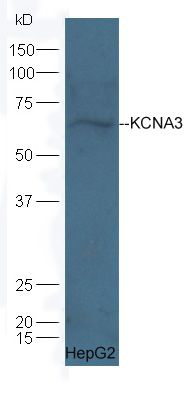产品货号 : mlR10229
英文名称 : KCNA3
中文名称 : 离子通道蛋白Kv1.3抗体
别 名 : Potassium Channel Kv1.3; HGK 5; HGK5; HLK 3; HLK3; HPCN 3; HPCN3; HuKIII; KCNA 3; KCNA3; KV1.3; MK 3; MK3; PCN 3; PCN3; Potassium channel 3; Potassium voltage gated channel shaker related subfamily member 3; Potassium voltage gated channel subfamily A member 3; Type n potassium channel; Voltage gated potassium channel subunit Kv1.3.
研究领域 : 细胞生物 神经生物学 信号转导 通道蛋白 转运蛋白
抗体来源 : Rabbit
克隆类型 : Polyclonal
交叉反应 : Human, Mouse, Rat, Chicken, Dog, Pig, Cow, Horse, Sheep,
产品应用 : WB=1:500-2000 ELISA=1:500-1000 IHC-P=1:400-800 IHC-F=1:400-800 ICC=1:100-500 IF=1:100-500 (石蜡切片需做抗原修复)
not yet tested in other applications.
optimal dilutions/concentrations should be determined by the end user.
分 子 量 : 63/58(hu/mo,rat)kDa
细胞定位 : 细胞膜
性 状 : Lyophilized or Liquid
浓 度 : 1mg/ml
免 疫 原 : KLH conjugated synthetic peptide derived from human KCNA3:485-575/575
亚 型 : IgG
纯化方法 : affinity purified by Protein A
储 存 液 : 0.01M TBS(pH7.4) with 1% BSA, 0.03% Proclin300 and 50% Glycerol.
保存条件 : Store at -20 °C for one year. Avoid repeated freeze/thaw cycles. The lyophilized antibody is stable at room temperature for at least one month and for greater than a year when kept at -20°C. When reconstituted in sterile pH 7.4 0.01M PBS or diluent of antibody the antibody is stable for at least two weeks at 2-4 °C.
PubMed : PubMed
产品介绍 : Potassium channels represent the most complex class of voltage-gated ion channels from both functional and structural standpoints. Their diverse functions include regulating neurotransmitter release, heart rate, insulin secretion, neuronal excitability, epithelial electrolyte transport, smooth muscle contraction, and cell volume. Four sequence-related potassium channel genes - shaker, shaw, shab, and shal - have been identified in Drosophila, and each has been shown to have human homolog(s). This gene encodes a member of the potassium channel, voltage-gated, shaker-related subfamily. This member contains six membrane-spanning domains with a shaker-type repeat in the fourth segment. It belongs to the delayed rectifier class, members of which allow nerve cells to efficiently repolarize following an action potential. It plays an essential role in T-cell proliferation and activation. This gene appears to be intronless and it is clustered together with KCNA2 and KCNA10 genes on chromosome 1. [provided by RefSeq, Jul 2008].
Function:
Mediates the voltage-dependent potassium ion permeability of excitable membranes. Assuming opened or closed conformations in response to the voltage difference across the membrane, the protein forms a potassium-selective channel through which potassium ions may pass in accordance with their electrochemical gradient.
Subunit:
Heterotetramer of potassium channel proteins. Binds PDZ domains of DLG1, DLG2 and DLG4.
Subcellular Location:
Membrane; Multi-pass membrane protein.
Tissue Specificity:
Expressed in activated, but not resting, CD4+ T-cells and activated monocytes.
Similarity:
Belongs to the potassium channel family. A (Shaker) (TC 1.A.1.2) subfamily. Kv1.3/KCNA3 sub-subfamily.
SWISS:
P22001
Gene ID:
3738
Important Note:
This product as supplied is intended for research use only, not for use in human, therapeutic or diagnostic applications.
产品图片












